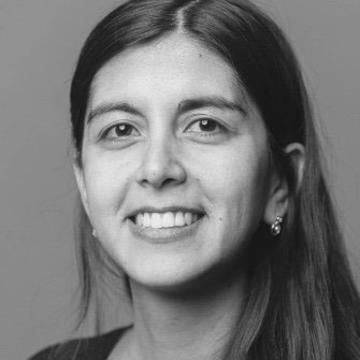Fernanda Duarte Gonzalez

Professor Fernanda Duarte Gonzalez
Associate Professor of Computational Organic Chemistry
Research interest: Computational Chemistry, Reaction Mechanisms, Biomimetic Catalysts, Physical Organic Chemistry and Enzyme Catalysis.
Techniques: ab initio (QM) approaches, Density Functional Theory (DFT), Molecular Dynamics (MD), Machine Learning.
Our team's research focuses on developing computational methodologies that help to elucidate complex (bio)chemical mechanisms and guide the design of novel catalysts and synthetic approaches. The group strives to break down some of the traditional barriers within chemistry, combining expertise in physical organic, supramolecular, and computational chemistry.
Reaction Mechanism Elucidation and Automation: A major theme in our group is the elucidation of reaction mechanisms, including electronic properties of the species involved and the effect of the environment in their reactivity. We have discovered fascinating aspects of reactivity in complex biosynthetic pathways (ACIE 2017, 56, 6813; ACIE 2018, 57, 6198) and introduced a unifying framework to rationalise the unusual reactivity of strained molecules, guiding synthetic efforts to access pharmaceutically relevant scaffolds (ACS Catalysis, 2019, 9, 9568; Chem. Sci., 2020, 11, 4895; Nat. Commun. 2021, 12, 1644).
To make reaction mechanism elucidation simpler, we have recently developed a computational tool named autodE that combines chemical knowledge and automation to facilitate the elucidation of a broad range of reaction classes (Angew. Chem. Int. Ed. 2021, 60, 4266).
Machine Learning and chemical reactivity
To progress in the computational prediction of reactions in solution, efficient and accurate methods are necessary. Our group has recently developed reactive machine learning (ML) potentials, demonstrating the applicability of these models in relevant applications, such as modelling chemical reactions in the condensed-phase and supramolecular assemblies (ChemRxiv 2021 Preprint).
We have also introduced computational workflows to generate mathematical relationships between experimental reaction outcome (e.g., stability, enantioselectivity, and yield) and physical organic descriptors. For example, we developed a simple predictive model to design configurationally stable secondary diarylamines (Angew. Chem. Int. Ed. 2020, ASAP). A similar approach has been used to establish the yield-determining factors in a reductive functionalisation of tertiary amides (ACS Catalysis, 2020, ASAP). With these methodologies, we aim to guide the design of new reactions and catalysts scaffolds.
Supramolecular design for catalysis and sensing
Another central theme of research within the group is the modelling of supramolecular assemblies as biomimetic alternatives for catalysis and sensing. We have initiated a programme to develop efficient computational tools (cgbind.chem.ox.ac.uk, J. Chem. Inf. Model. 2020, 60, 7) to characterise and design supramolecular systems for catalysis and bioremediation applications.
Our initial work focused on the computational characterisation of Pd2L4 metallocages, which have shown contrasting Diels-Alder catalytic efficiency depending on the nature of the ligand. Employing quantum mechanics (QM) and molecular dynamics (MD) simulations, we demonstrated how subtle differences in the cage framework affect the cages' dynamics and, consequently, their binding and catalytic properties. We have extended these approaches to study a broader range of metallocages and reactions (JACS 2020, 142, 3, 1300; JACS 2020, 142, 5, 2134; JACS 2020, 142, 41, 17743).
Enzyme catalysis
The fundamental understanding of chemical is vital in elucidating the origin of selective binding and catalysis in proteins and enzymes. Through experimental collaborations, and building on our expertise in physical organic chemistry and computation modelling, we have explored protein binding, enzyme catalysis and promiscuity. For example, our work on phosphate/sulfate hydrolases combined various probes that as a whole resolved long-standing debate and rendered the first unifying mechanistic framework to understand this process ubiquitous in biology (JACS 2015, 137, 1081 & 137, 9061; JACS 2016, 138, 10664, PNAS 2018, E7293). We have recently undertaken a detailed characterisation of the binding and inhibition mechanisms of the SARS-CoV-2 main protease (MPro). To understand the relationship between sequence and specificity/proteolysis activity, we modelled the binding of both the native (eleven 11-mer peptide) substrates and potential inhibitors of SARS-CoV-2 Mpro, through a combination of MD simulations and QM calculations.
Fernanda obtained her PhD from the Pontificia Universidad Católica de Chile (PUC) under the supervision of Prof. Alejandro Toro-Labbe. Her project focused on the formulation and application of theoretical frameworks to characterise chemical processes by employing Density Functional Theory (DFT), and hybrid Quantum Mechanics/Molecular Mechanics approaches. After graduation, she joined the Department of Cell and Molecular Biology at Uppsala University, where she pursued training in biomolecular modelling. In December 2015, she moved to the University of Oxford with a Royal Society Newton Fellowship, working in the area of computational organic chemistry. Fernanda joined the School of Chemistry at Edinburgh in January 2017 with a Chancellor's Fellowship. In October 2018, she returned to Oxford and took up her first faculty appointment as Associate Professor at the Department of Chemistry.
Fernanda has received various accolades; including the L'Oreal-UNESCO Women in Science award (2009), a Pre-doctoral Fulbright scholarship (2010), a fellowship from the Bert and Kuggie Vallee Foundation to attend the Lindau Nobel Laureate Meeting (2013), a Marie Curie Career Grant (2015), the Newton Fellowship (2015), and the MGMS Frank Blaney Award from the Molecular Graphics and Modelling Society (2020). To date, Fernanda has published more than 50 peer-reviewed articles and edited the book From Physical Chemistry to Chemical Biology: Theory and Applications of the Empirical Valence Bond Approach (Wiley 2017). She is also a founding member of the UK-India Innovation & Sustainability Chemistry Consortium and the LatinXChem initiative.




